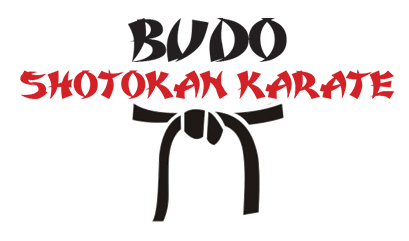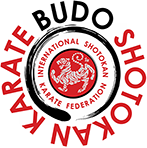
Introduction
Welcome to Budo Shotokan Karate. New students are always welcome and we recognize that you are an essential and valuable part of our karate training group. We look forward to working with you and hope to see you thrive as we begin this journey together.
Shotokan karate training helps increase physical fitness, confidence, improved motor skills, flexibility, speed, concentration, discipline and personal safety. Karate is practiced by young and old alike. Anyone can learn karate no matter what your age, gender and physical condition. Karate encompasses so much more than just physical training. The mental & spiritual benefits of karate training are endless and increases as you progress along this journey.
Learning karate can be an extremely awkward experience at first. Not only are you exercising your body in ways that you have never done before, but it also encompasses mental & spiritual aspects that you may have not foreseen. Karate is deeply rooted in Eastern philosophies and with that comes a different way of thinking. Mutual respect for one another is of utmost importance. That being said, persistence and a positive attitude towards learning will help overcome this initial awkwardness.
Below you will find some useful information that will attempt to answer the most commonly asked questions and the rules and etiquette of the dojo (training place). If you have questions, please do not hesitate to ask the Sensei (Teacher) or Sempai (Senior Student).
What is Karate?
Karate has roots that can be traced back 1400 years, from the time Daruma Bodhidharma, the founder of Zen Buddhism, left India and traveled to China to present lectures on Buddhism. His teachings were passed down to the monks of the Shao-lin Temple. Daruma’s teachings spread throughout China. Eventually the art reached the Ryukyu Islands and Okinawa.
In a generic sense, Karate is a Japanese system of unarmed combat using the hands and feet to deliver and block blows. It was formalized in Okinawa in the 17th century and popularized via Japan around 1920 by the founder of modern day Karate Ginchin Funakoshi. That being said, Karate encompasses so much more that just unarmed combat using hands and feet. The mental and psychological aspects of Karate are just as important (if not more important) than the physical aspects. People who train in Karate do it for different reasons. Some do it for sport, some do it for health reasons and some do it for self-defense. The longer one studies Karate the greater the benefits one will reap, such as better physical conditioning, weight loss, stress relief and improved mental capabilities. Whatever reasons for wanting to train, you will find regular training is beneficial in many aspects of your life.
Understanding Karate-Do:
Karate-do {ka-rah-tay doe}, the “way of the empty hand”, (Kara meaning “empty”, te meaning “hand” and do meaning “way”) is a path to self development. Karate is best known as a method of self-defense, but self-defense is only a by-product of true karate training. Karate-do develops character through training; the karate-ka (karate student) learns to surmount any obstacle, tangible or intangible.
“The ultimate objective of karate-do lies not in determining who is the winner and the loser, but in the perfection of the character of the participants.” -Master Gichin Funakoshi, founder of modern karate.
Learning as a Beginner:
When new students begin classes, they will notice that the Sensei (Teacher) does not start all over again from the beginning for their benefit. Experience has shown that new students should jump right into training and follow along as best as they can. Mistakes will be made, expect to feel clumsy and uncoordinated, again, this is normal. As mentioned earlier, the initial experience can be awkward at first, but this will pass quickly if the student has a positive attitude and willingness to learn.
Ranking and Examinations:
Like other Japanese martial arts, The International Shotokan Karate Federation (ISKF) utilizes the “Kyu” and “Dan” system for ranks. As you can see below, colored belts are considered Kyu and black belts are considered Dan. Kyu tests are administered about every four month (not less) by Sensei Bruce Green (8th Degree Black Belt), and Dan tests are administered two times a year by a panel of ISKF Certified Examiners, including Sensei Green.
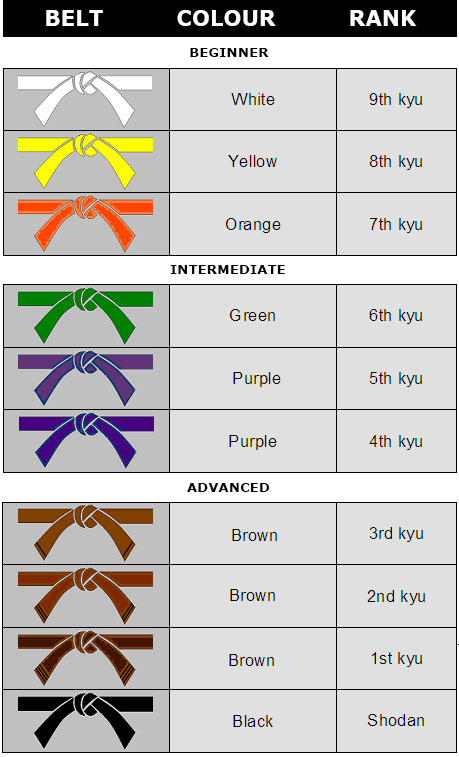
All Kyu tests require the student to demonstrate three components:
1) Kihon (Basic techniques)
2) Kata (Choreographed pattern of movements)
3) Kumite (Sparring).
All three components are equally graded. Ranking tests are not about the student’s ability to defend themselves or win competitions, but rather measuring their personal progress as they move up the Kyu and Dan ranks.
Students are not required to take Kyu or Dan examinations, but will not achieve higher belts without testing. Remember, testing is merely a gauge of self-progress.
List of Katas:
Kata Name # of Moves Kiai Points Meaning
1. Heian Shodan 21 9 & 17
2. Heian Nidan 26 11 & 26
3. Heian Sandan 20 10 & 20
4. Heian Yodan 27 13 & 25
5. Heian Godan 23 12 & 19
6. Tekki Shodan 29 15 & 29 Iron Horse
7. Tekki Nidan 24 16 & 24 Iron Horse
8. Tekki Sandan 36 16 & 36 Iron Horse
9. Bassai Dai 42 19 & 42 Storm a Fortress (Major)
10. Kanku Dai 65 15 & 65 To View the Sky (Major)
11. Jion 47 17 & 47 Temple
12. Empi 37 15 & 36 Flying Swallow
13. Jitte 24 13 & 24 Ten Hands
14. Hangetsu 41 11 & 40 Half Moon
15. Gankaku 42 28 & 42 Crane on a Rock
16. Bassai Sho 27 17 & 25 Storm a Fortress (Minor)
17. Kanku Sho 47 28 & 47 To View the Sky (Minor)
18. Chinte 33 9 & 32 Unusual Hands
19. Gojushiho Dai 62 54 & 61 54 Steps (Major)
20. Gojushiho Sho 65 57 & 64 54 Steps (Minor)
21. Meikyo 33 32 Bright Mirror
22. Unsu 48 36 & 48 Cloud Hands
23. Sochin 40 28 & 40 Preservation of Peace
24. Nijushiho 33 18 & 32 24 Steps
25. Wankan 24 24 King’s Crown
26. Jiin* 35 11 & 35 Temple (Minor)
How Long to Earn a Black Belt?
A common question a new student will ask is “How long it will take me to get a black belt?” On average it takes 4 -5 years to reach Shodan (lowest level of black belt). Please keep in mind that many factors will affect this like age, physical ability, attitude and perseverance in training. Karate is a life long endeavor and reaching the level of Shodan means that you are a serious and committed student who has a solid understanding of the basic techniques, but has not achieved mastery of the art. Never is a student “given” a belt. It must be earned through hard work, dedication and the right attitude/mindset. Remember the journey is the most important aspect of training, not the attainment of the belt.
Karate Uniform (Gi):
Gis are the uniform you wear to train, and are available for purchase from Sensei or online (https://www.karatesupply.com) and make sure to only buy Gis in the color white. Make sure to look at the sizing chart to get the right fit. Ask another student for help on how to put on your gi and tie your belt, they will be happy to assist you. Do not wear jewelry; it could cause injury to yourself or another student. Females should wear a sports bra under their gi top. Some people like to wear a t-shirt under their gi. Long hair should be pulled back into a ponytail with soft elastic (no barrettes, clips or hard plastic). New students are not required to wear a Gi at first, but will need to wear a Gi before the 1st Kyu exam if they wish to test for rank.
Kiai:
The sound a student makes while kicking or punching is called a “kiai” (kee – eye). Kiai is a compound of ki, meaning energy or mood, and a(u), meaning join or fit. It is a short, sharp sound coming from the diaphragm that is meant to focus energy during the technique. Each student has their own unique kiai, and you will develop yours over time.
Dojo Rules & Student Conduct:
The “dojo” means a place where we train. In traditional Japanese karate, etiquette is just as important as the physical aspects, if not more.
•DO NOT train if you are sick or on medication that may impair your ability or judgment.
•DO NOT fight inside or outside the dojo. This is cause for immediate expulsion.
•DO NOT be disrespectful to Sensei or other students. Disrespectful behavior will not be
tolerated.
•DO NOT eat candy or chew gum during class.
•DO NOT drink alcohol or use drugs before class.
•DO NOT lean against the walls or sit down during class.
•DO NOT talk during class unless you’ve been asked a question by Sensei.
•DO NOT comment or ask too many questions that may disrupt the flow of the class.
•DO NOT cross your arms or rest your hands on your hips. This is considered a sign of disrespect.
•DO NOT bring any valuables to the Dojo. We are not responsible for lost or stolen items.
•DO NOT leave the Dojo with a stranger under any circumstances if you are a minor, even if he/she tells you that your parents asked them to pick you up.
•DO pay dues at beginning of every month.
•DO be on time for classes (consider the time that you will need to use the restroom, change into the Gi, or perform other necessary preparation).
•DO remove your shoes and socks before entering the dojo and leave them in designated area.
•DO bring your personal water bottle for training and make sure to fill it up before the class.
•DO bow to the front of the dojo prior to entering or leaving.
•DO turn off or silence your cell phones.
•DO take care of restroom business before or after class. If you need to do so during the class, discreetly excuse yourself and go to the restroom, no need to ask Sensei for permission.
•DO remove all jewelry (rings, watches, earrings, necklaces, etc…) before class.
•DO notify Sensei immediately if you are not feeling well or become injured, before, during or after the class.
•DO keep fingernails and toenails clipped and clean.
•DO keep long hair pulled back into a ponytail with soft elastic (no barrettes, clips or hard plastic).
•DO wear a “sports tank top” under Gi if female Karate practitioner.
•DO keep your uniform (gi) clean and in good repair.
•DO warm-up outside of the dojo and kneel and wait for sensei to acknowledge you when you are late.
•DO turn and face the back of the dojo when adjusting your gi or belt.
•DO accept constructive criticism (from Sensei and Sempais) with a positive attitude.
•DO respond to Sensei using “hai” or “oss” for positive acknowledgement.
•DO ask Sensei before leaving the dojo during class, unless it is for the restroom.
•DO use proper titles (e.g. Sensei, Sempai) when addressing instructor and senior students.
•DO practice the art of humility, especially as you attain higher ranks.
•DO memorize and practice the Dojo Kun. These principles apply inside as well as outside the dojo.
It is the responsibility of all students (colored belts and black belts) to ensure that new and existing students are aware of and follow the dojo rules and etiquette.
The Karate Class: Procedure and Ritual
Bowing:
Bowing is a Japanese tradition meant to show courtesy and respect. We bow in respect of the place that we train as well as to demonstrate respect toward each other. Please remove shoes before entering the training area (Dojo).
• Bow as you enter the Dojo.
• Bow as you walk into or leave the training area.
• Bow to Sensei before and after an exercise.
• Bow to your partner before and after an exercise.
As a traditional martial art, we begin and end class with an opening and closing ceremony.
Procedure for opening class:
1. Line-up: All students line up facing the front (Shomen). Higher ranking students to the right, lower ranking students to the left.
2. Kneeling: The instructor kneels first. When the instructor is down, remaining black belts kneel followed by the remaining students who kneel down together and at the same time. Proper position when kneeling requires that the back is straight, hands are on your thighs, and the knees form a straight line amongst all students.
3. Meditation and Salutes: The senior student gives the following commands:
a. “Seiza” (kneel down in formal meditation position).
b. “Moku-so” (meditation; close eyes, empty your mind, back straight, controlled breathing, lasts 10 to 20 seconds).
c. ” Moku-so Yame ” (finish meditation, open eyes, mind alert).
d. “Shomen-ni-Rei” (all students bow to the front/shomen).
e. “Sensei-ni-Rei” (all students bow to the instructor/sensei).
4. Calisthenics: The instructor will stand, instruct students to stand and spread out. The assistant instructor or other senior student will then lead the class through about 10 minutes of calisthenics. These will be performed to both warm up and limber up the body.
Procedure for ending class:
1. Line up: If necessary, students should turn toward the back of the dojo and straighten their uniforms. Then, line up as at the beginning of class.
2. Kneel down: As at the beginning.
3. Meditation and salutes: The lead student gives the following commands:
a. “Seiza” (as when starting class).
b. “Moku-so”
c. “Moku-so Yame”
d. “Dojo-Kun”; lead student then recites the dojo-kun, as shown below, and all students repeat the phrase following the lead student.
1. Seek perfection of character
2. Be faithful
3. Endeavor
4. Respect others
5. Refrain from violent behavior.
e. “Shomen-ni-Rei” (all students bow to the front/shomen).
f. “Sensei-ni-Rei” (all students bow to the instructor/sensei).
g. “Sempai-ni-Rei” (all students bow to the assistant instructor and black belts).
4. Rise and finish: Instructor will stand up followed by the remaining black belts, then followed by the remaining students. The black belts should stand as one group and the remaining students should also stand as one group.
Entering class when late: If the class has started, warm up on your own, enter the dojo and bow, then kneel at the side until the instructor signals for you to rise and join the class.
Dojo Kun in Japanese:
Hitotsu “Jinkaku kansei ni tsutomurukoto” {Gin-?cah-?coo can-?say knee sue-?toe-?more-?oh-?coe-?toe}—Meaning Strive for perfection of character
Hitotsu “Makotono michi wo mamorukoto” {Mah-?coe-?toe-?no me-?chee who mah-?more-?loo-?coe-?toe}—Meaning to defend the path of truth
Hitotsu “Doryokuno seishin wo yashinaukoto’’ {Door-?ee-?oh-?coo-?no say-?chin who yah-?she-?now-?coe-?toe}—Meaning to foster the spirit of effort
Hitotsu “Reigi wo omonzurukoto” {Lay-?ghee who oh-?moan-?zoo-?row-?coetoe}—Meaning to honor the principle of etiquette
Hitotsu “Kekkino yu wo imashimurukoto” {Kay-?key-?no you who e-?mash-?emore-?oh-?coe-?toe}—Meaning to guard against impetuous courage.
Organizations:
International Shotokan Karate Federation
(iskf.com)
The International Shotokan Karate Federation (ISKF) was established in 1977. The ISKF coordinates efforts to bring ISKF programs and develop ISKF organizations throughout North, Central, and South America, Caribbean, Europe, Middle East, Africa, Australia and Asia. The ISKF also administers the Instructors Training Program internationally.
Master Teruyuki Okazaki, 10th degree black belt, is the Chief Instructor and Chairman of the ISKF. Master Okazaki was the right-hand man to Master Nakayama in the early days of establishing the Japan Karate Association (JKA). He also played a crucial role in establishing and developing JKA tournament rules and the JKA Instructors Training Program.
ISKF of Colorado
(iskfmountainstates.com)
The ISKF of Colorado was established in 1974 with Sensei Yaguchi as Chief Instructor and Chairman. The ISKF of Colorado is also the headquarters for the Mountain States Region of the ISKF. The ISKF of Colorado is one of only five organizations sanctioned to offer the ISKF Instructors Training Program in North, Central, and South America.
Boulder Shotokan Karate
(shotokan.net)
Boulder Shotokan Karate (previously the JKA of Boulder) was established in 1980 with Sensei Bruce Green as Chief Instructor (8th Dan). Boulder Shotokan Karate is an active member of the ISKF, and is one of the oldest branch dojos in the Mountain States Region.
Budo Shotokan Karate
(budoshotokan.com)
Budo Shotokan Karate was established in 2017 with Sensei Chad Callaghan as Chief Instructor (3rd Dan). We are also an active member of the ISKF.
Background of the Instructors:
Master Yutaka Yaguchi, 9th Dan
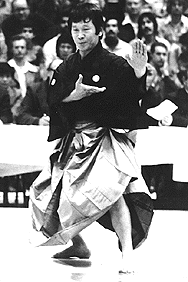
Born in 1932 in Hiroshima, Japan, Sensei Yaguchi began karate training in 1952. He tested under Master Funakoshi for his first and second degree black belts. As an outstanding collegiate karate competitor, he was picked as an applicant to the newly established JKA Instructors Training Program. He is one of the first graduates of the renowned and prestigious JKA Instructors Training Program. During this time, he established himself as a prominent competitor and finalist in the annual JKA All Japan Tournaments from 1957 to 1963.
In 1965, Sensei Yaguchi came to the United States and instructed in the Los Angeles area. In 1974, he moved to Denver to assume the responsibilities of Regional Director of the Mountain
States Region. He became Technical Director of the International Shotokan Karate Federation (ISKF) in 1977. Sensei Yaguchi also serves as Chief Instructor of western Canada.
In 1986, Sensei Yaguchi began providing the instruction for one of only five JKA/ISKF Instructors Training Programs in North, Central, and South America. As one of the first graduates of the JKA Instructors Training Program, he has played an important role in the growth of American Shotokan karate and the internationalization of Shotokan karate.
Sensei Bruce Green, 8th Dan
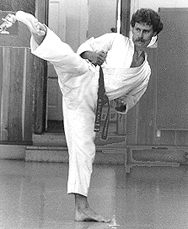
Sensei Green began his training in 1970 under one of the first non-Japanese graduates of the JKA Instructors Training Program — Sensei Greer Golden. Sensei Green was a finalist in the JKA National Collegiate Karate Championships from 1973 to 1975. After finishing graduate school in Illinois, Sensei Green had the good fortune to move to Colorado after receiving a position with the newly created Solar Energy Research Institute (SERI, now the National Renewable Energy Laboratory/NREL) in 1978.
In 1980, Sensei Green was appointed Assistant Instructor to Sensei Yaguchi and in the same year became Chief Instructor of the JKA of Boulder (now Boulder Shotokan Karate). Sensei Green competed successfully in international, national, and regional tournaments from 1973 to 1988. In 1995, Sensei Green graduated from the esteemed JKA Instructors Training Program as one of Sensei Yaguchi’s first students to graduate from the Mountain States Region.
Sensei Chad Callaghan, 3rd Dan
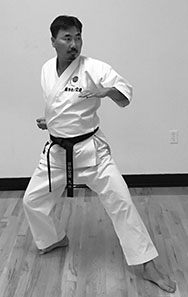
Sensei Callaghan grew up in Boulder, Colorado and began training under Sensei Green in 1985. He continues to train with Sensei Green along with his wife and daughter on a weekly basis and enjoys competing in local, regional & national tournaments. Sensei Callaghan is also an instructor at CU Shotokan Karate/University of Colorado ISKF along with CJ Herman (5th Dan). He tested and received his Shodan and Nidan from Master Yaguchi. Sensei Callaghan is currently enrolled in the world renowned ISKF Instructor Training Program.
Japanese Karate Terminology:
Block (Uke – pronounced “oo-kay”)
Jodan Age-uke (ah-geh-oo-kay): Upper block (Raising)
Shuto-uke (shoe-toe oo-kay): Knife-hand block
Uchi-uke (oo-chee oo-kay): Inside block
Gedan-barai (Geh-dahn bah-rye): Down block
Soto-uke (so-toh oo-kay): Outside center block
Punch (Zuki – pronounced “zoo-key”)
Age-zuki (ah-geh zoo-key): Rising punch
Choku-zuki (cho-koo zoo-key): Straight punch
Chudan-zuki (chew-dahn zoo-key): Middle area punch
Gyaku-zuki (gya-koo zoo-key): Reverse punch
Jodan-zuki (joe-dahn zoo-key): Face level punch
Kagi-zuki (ka gee zoo-key): Hook punch
Oi-zuki (oh-ee zoo-key): Stepping punch
Tate-zuki (tah-the zoo-key): Vertical punch
Ura-zuki (oo-rah zoo-key): Close punch
Kick (Geri – pronounced “geh-rhee”)
Keage (key-ah-geh): Snap kick
Kekomi (kay-koh-me): Thrust kick
Mae-geri (mah-eh geh-rhee): Front kick
Mawashi-geri (mah-wha-she geh-rhee): Round kick
Ushiro-geri (oo-she row geh-rhee): Back kick
Yoko-geri-kaegi (yoh-koh geh-rhee key-ah-geh): Side snap kick
Yoko-geri-kekomi (yoh-koh geh-rhee key-ah-geh): Side thrust kick
Strike (Uchi – pronounced “oo-chee”)
Empi-uchi (en-pee oo-chee): Elbow strike
Haishu-uchi (hi-shoo oo-chee): Back hand strike
Haito-uchi (hi-toe oo-chee): Ridge-hand strike
Ippon-ken (eep-pone ken): One-knuckle fist
Nukite (noo-key-teh): Spear hand
Kentsui-uchi (ken-tsue-ee oo-chee): Hammer fist strike
Shuto-uchi (shoe-toe oo-chee): Knife hand strike
Teisho-uchi (tay-sho oo-chee): Palm hand strike
Uraken-uchi (oo-rah-ken oo-chee): Back fist strike
Stance (Dachi – pronounced “dah-chee”)
Fudo-dachi (foo-dough dah-chee) Rooted stance
Hachiji-dachi (hah-chee-gee dah-chee): Open leg stance
Hangetsu-dachi (hahn-geh-tsue dah-chee): Half-moon stance
Heiko-dachi (hay-koh dah-chee): Parallel stance
Kamae (kah-may): Sparring posture
Kiba-dachi (key-bah dah-chee): Side stance (horse stance)
Kokutsu-dachi (koe-koo-tsu dah-chee): Back stance
Kosa-dachi (koe-sah dah-chee): Crossed legged stance
Neko-ashi-dachi (neh-koh ah-she-dah-chee): Cat stance
Sanchin-dachi (san-chin dah-chee): Hour-glass stance
Shizentai (she-zen dah-chee): Natural position
Teiji-dachi (the-gee dah-chee): T stance
Zenkutsu-dachi (zen-koo-tsue dah-chee): Front stance
Numbers
Ichi (ih-chee): One
Ni (nee): Two
San (sahn): Three
Shi (she): Four
Go (go): Fi
Roku (roo-koo): Six
Shichi (Shih-chee): Seven
Hachi (Hah-chee): Eight
Ku (koo): Nine
Ju (joo): Ten
General Terms
Budo (boo-doh): Martial way
Bunkai (bun-kye): Applications
Chudan (chew-dahn): Chest area
Dan (dahn): Black belt rank
Do (doh): Way/path
Dojo (doh-joh): Training area
Gasshuku (gas-shoe-koo) Summer camp
Gedan (geh-dahn): Lower body area
Gi (ghee): Uniform
Gohan-kumite (goh-hon koo-mih-tay): Five step sparring
Hai (hi): Yes
Hajime (hah-zhim-ay): Begin
Hidari (he-dah-rhee): Left
Ippon kumite (eep-pohn koo-me-teh): One step sparring
Jiyu ippon (jye-oo ih-pon): Semi-Free style sparring
Jiyu-kumite (gee-you koo-me-teh): Free sparring
Jodan (joh-dahn): Face area
Kamae (kah-may): Sparring posture
Karate (kah-rah-teh): Empty hand
KarateKa (kah-rah-teh-kah): Karate student
Kata (kah-tah): Form
Ki (key): Mind, Spirit, Energy Kiai (key-aye): Focusing shout Kihon
(key-hohn): Basic technique
Kihon kumite (key-hone koo-me-teh): Basic sparring
Kime (key-may): Focus of power
Kumite (koo-me-teh): Sparring
Kyu (kyoo): White/Brown belt Rank
Mae (may): Front
Makiwara (mah-key-wha-rha): Punching board
Mawate-te (mah-wha-tay): Turn around
Migi (me-ghee): Right
Osu (oh-soo): Greeting
Rei (rey): Bow
Sanbon kumite (san-bohn koo-me-teh): Three step sparring
Seiza (sigh-zah): Sitting position
Sempai (sehm-pye): Senior student
Sensei (sehn-seh-ee): Instructor
Shizen-tai (she-zen tah-ee): Natural position
Tai sabaki (tye sah-bah-key): Body movement
Waza (wah-zah): Technique
Yame (yah-may): Stop
Yoi (yoy): Ready
Zanshin (zahn-shin): Following through technique
Suggested Reading Material:
1. Nakayama, M., Dynamic Karate
2. Nakayama, M., Best Karate, Books #1 and #2
3. Okazaki, T., Textbook of Modern Karate
6. Nakayama, M., Practical Karate, Books I and II
Affiliations:
International Shotokan Karate Federation (ISKF)
ISKF, Mountain States Region
Boulder Shotokan Karate (ISKF)
Budo Shotokan Karate (ISKF)
